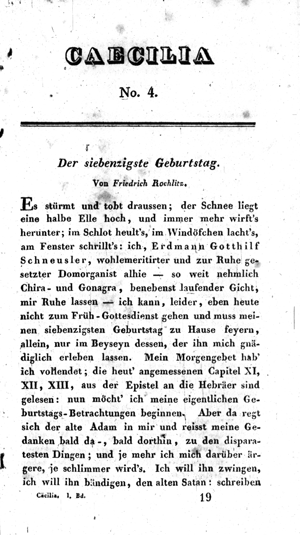Cäcilia, eine Zeitschrift für die musikalische Welt, herausgegeben von einem Vereine von Gelehrten, Kunstverständigen und Künstlern
Prepared by Christine Heyter-Rauland
(1994)

After the Leipzig Allgemeine musikalische Zeitung, Cäcilia is the principal German-language resource for information on musical life and music criticism during the first half of the nineteenth century. Founded in 1824, it was published in Mainz by B. Schott’s Söhne and edited, until 1839, by the Darmstadt lawyer, music scholar, and composer Gottfried Weber. Following Weber’s death, Cäcilia ceased publication until 1842. At that point, the music theorist Siegfried Wilhelm Dehn, custodian of the Musikabteilung at the Königliche Bibliothek, Berlin, became editor until 1848. Despite significant differences in leadership style, both editors maintained the scholarly bent typical of Cäcilia. It is this inclination, together with the almost complete omission of day-to-day reviews, that distinguishes this journal from other contemporary music periodicals.
At the very beginning of the first issue, Gottfried Weber, presumably, outlined the structure of Cäcilia. It was to contain six-parts, each dealing with a specific subject: theory, criticism, historical articles, correspondence, exhibits, and entertainment. The “theory” section treats not only Weber’s favorite subjects (music theory, acoustics and organology), but also the philosophy of music, musical aesthetics, and music pedagogy. Writings in this section are varied and almost always on a very high level. The “criticism” section reflects Cäcilia’s conservative bent next to its progressive, scientific side. Compositions by Schubert and Chopin are barely mentioned, clearly differentiating the content of this journal from that of the Neue Zeitschrift für Musik. The category “historical articles” contains contributions on significant musical events of the period ranging widely in subject matter and including those of ethnomusicological interest.
The considerable scope and quality of Cäcilia resulted from a large number of contributors drawn from a highly diversified body of professionals. During Weber’s tenure, these included a pool of regular collaborators among whom were theologian, music critic and composer Gottfried Wilhelm Fink; the Göttingen University music director Johann August Günther Heinroth, a specialist in notation; the renowned organist Johann Christian Heinrich Rinck; and Ignaz von Seyfried, who shared his editor’s preference for Mozart, but whose Beethoven reviews helped balance Weber’s ambivalent opinion of this composer’s works. Occasional contributors consisted of the physicists Chladni and Wilhelm Weber; instrument maker Carl Almenräder; and Jeanette von Haza—the only female contributor—a writer sympathetic to the causes espoused by Robert Schumann, and, hence, close to the Neue Zeitschrift für Musik.
Upon becoming editor of Cäcilia, Dehn respected Weber’s editorial legacy and introduced only one new column, “Bibliography and music literature,” in which Anton Schmid’s important “Beiträge zur Literatur und Geschichte der Tonkunst” appeared. However, the “entertainment section” diminishes substantially in size, while the category “historical articles” increases. Ample space is devoted to music from the middle ages to the baroque period, with particular scholarly emphasis placed on Bach, folk song and chorales. As Schumann and Chopin receive no mention, and Mendelssohn is the subject of only a few articles following his death in 1848, it seems fair to say that the ideological gap separating Cäcilia from the Neue Zeitschrift für Musik was widening.
